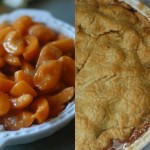
I can make bubbling crisps, chewy cookies, melting brownies, moist cakes and quick breads. But I haven’t tried pie.
Well, that’s not quite true. The last time I made pie, it tasted like a cheese plate minus the saving grace of cheese: fruit and crackers. Oh, the shame. And I’m a baker, so I was really upset. So I never made it again. Besides, I reasoned to myself, I don’t have a food processor. And I don’t want to use shortening—scary stuff in a can! And yes, I know there are other options besides transfats, or besides just butter. Pre-packaged crusts seemed to go against why I love to bake. So, I went on, rationalizing my way through all these excuses.
See, I also thought that pie crust was like the other forms of baking that I’ve done: mostly following a recipe, playing very little with the amounts or the ingredients, but mostly using the best-quality ingredients possible. But I cook differently than I bake—I do find recipes, but I often play with them quite a bit. This ingredient sounds good, but maybe I’ll use this instead of this. I’ll look, and taste, when I’m cooking, and mostly relying on my palate’s memory. It’s a lot more of an improvisational game than a putting together a model train, or painting by numbers.
So this week I was thrilled to see some different approaches to pie crust, and to making pie. My dear friend Shauna decided to give me a pie crust crash course. I watched her cut butter, roll her index fingers and thumbs together in order to coat the butter with flour, and pat crust into her pie plates. It was a busy afternoon—two pies, one by hand and one by food processor, plus an online Facebook/Twitter pie party of 1500 participants, plus four children six and under needing different kinds of attention and snacks—but I learned so much.
If, like me, you are a piecrust novice, I thought I’d list a few things here that might be useful. Here are some things I wanted to remember for myself when making pie. They are not hard-and-fast rules–looking at different recipes, pie-makers will swear by their own rules, which seem to vary widely–but there are some guidelines that I can’t wait to put into practice.
• Chill everything before beginning to mix: your flour, your butter (it should be like ice cubes), your hands, your bowl. Maybe the water, which can be ice water.
• Make your filling first, especially with a fruit pie, so the fruit can macerate and rest in its juices. Cut your working recipe in half, and make the bottom buy albuterol inhaler online no prescription crust, leaving the other half of the ingredients to remain chilling in the freezer/refrigerator. Then once you have rolled out and patted the bottom crust in, you can make the top crust.
• If using a food processor, use about 8 pulses in order to cut the butter into the flour and salt. You want it to look something like dry cottage cheese curds.
• Kerrygold butter is the best. Using European butter with a high butterfat content helps the flavor.
• Work quickly, but not frantically.
• When working the dough with your hands, there’s a motion you can use to cut the butter into the flour—or rather, coat the butter with the flour. Holding both hands out in front of you, pinkies down, practice rolling your index fingers down the length of your thumbs. That’s approximately the motion you want to make in order to meld the butter with the flour.
• Contrary to what Pepperidge Farm and others might have you believe (at least, I did), the goal is actually not a uniformly consistent ball of dough, like pizza dough. You do want it to cohere, but you don’t need it to be smooth all the way through.
• A few lumps of butter throughout the dough actually help. They do not all need to be the size of a pea, either; some might be as large as a shelled walnut.
• The end result, the ball of dough, should feel something like cold cream cheese.
• Most importantly, chill your attitude. Be relaxed, be comfortable, be happy. It’s pie. It’s made to be shared.
Watching Shauna make the pies was inspiring, and it made me understand how I could get into pie-making this summer: it is baking as I like to cook. It is playful, it is flexible, it is creative, and it is pleasurable.
I saw how piemaking could be a meditative act, seeing how the baker should see what is happening to the dough, and simply roll (sorry) with the punches and adjust accordingly. I realized that I want a French rolling pin, which looks more like a mallet slightly tapered at both ends, rather than a log with handles at each end. Christmas elves, take note, please.
And I realized that the truth is that I am a perfectionist, and I hate getting stuff “wrong,” and I have a hard time fixing my “mistakes,” large or small, or starting all over again. I really need to get over that if I am going to return to my childhood dream: being a writer.
It’s time to make some pie. I’ll let you know how it turns out.
Readers: any pie tips for me, or any favorite recipes? Or, do you have something “basic” that you’ve been afraid to make, and why?
